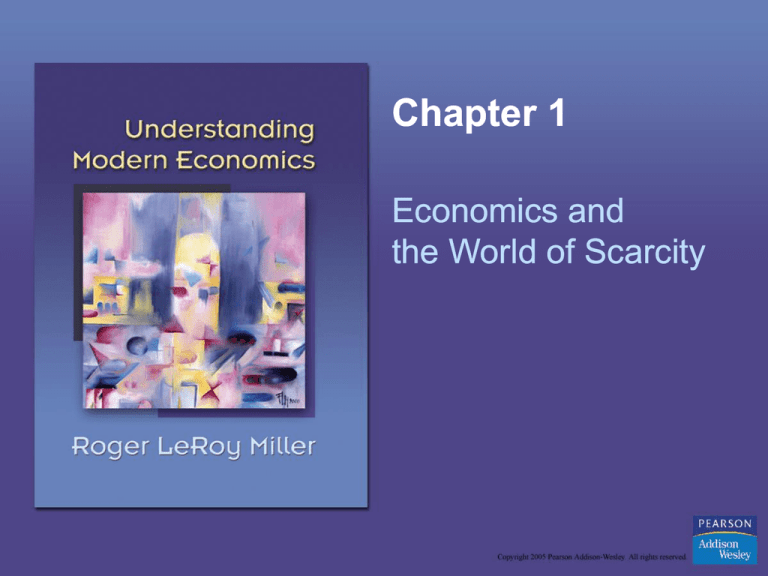
Chapter 1
Economics and
the World of Scarcity
Learning Objectives
• Understand the difference between needs
and wants.
• Understand why scarcity exists.
• Determine how one measures opportunity
cost.
• Show the relationship between opportunity
cost, trade-offs, and the production
possibilities curve.
• Show the relationship between the production
possibilities curve and economic growth.
Copyright © 2005 Pearson Addison-Wesley. All rights reserved.
1-2
Economics
• Economics is a social science that
studies how people allocate their limited
resources to try to satisfy their unlimited
wants.
• Economics is the study of how
people make choices.
Copyright © 2005 Pearson Addison-Wesley. All rights reserved.
1-3
Needs vs. Wants
• The term need applies to the bare
minimum physical necessities that allow
you to survive: bare minimum of basic
food, shelter, and clothing.
Copyright © 2005 Pearson Addison-Wesley. All rights reserved.
1-4
Needs vs. Wants
• Wants include those desires that you
are able and also unable to pay for.
• They are unlimited.
Copyright © 2005 Pearson Addison-Wesley. All rights reserved.
1-5
Scarcity
• Scarcity exists because nature does
not provide us with all of the resources
required to satisfy our unlimited wants.
• For many people, the scarcest resource
they face is time.
Copyright © 2005 Pearson Addison-Wesley. All rights reserved.
1-6
Goods and “Bads”
• Goods are defined as those items that
give us satisfaction when we consume
them. Examples include a sandwich, a
cup of coffee, a warm sweater, etc.
Copyright © 2005 Pearson Addison-Wesley. All rights reserved.
1-7
Goods and “Bads”
• “Bads” are the byproducts of production
and consumption that we would prefer
to do without. They include pollution of
any type, such as smog.
Copyright © 2005 Pearson Addison-Wesley. All rights reserved.
1-8
Scarcity and Decision Making
• Scarcity forces us to make choices.
• When we decide to do anything, we are
implicitly deciding against doing
something else. In other words, we are
giving up an opportunity.
Copyright © 2005 Pearson Addison-Wesley. All rights reserved.
1-9
Opportunity Cost
• The opportunity cost of every
economic decision we make is the value
of the next-best alternative .
• It is the value of the alternative that
we had to forgo, or do without, for
the decision or choice we made.
Copyright © 2005 Pearson Addison-Wesley. All rights reserved.
1-10
Scarcity and Trade-offs
• Scarcity forces us to make choices.
• When we change our mind, and choose
a different alternative, we face a tradeoff.
Copyright © 2005 Pearson Addison-Wesley. All rights reserved.
1-11
Scarcity and Trade-offs
• Trade-off is the sacrifice of one good or
service to purchase or produce another
good or service.
Copyright © 2005 Pearson Addison-Wesley. All rights reserved.
1-12
Resources
• Resources are things (goods or
services) used to produce other goods
and services to satisfy people’s wants.
Copyright © 2005 Pearson Addison-Wesley. All rights reserved.
1-13
Production Possibilities
• Most businesses can use their
resources and technology to produce
different goods or services.
• When businesses produce more
of one good or service, they must
produce less of another.
Copyright © 2005 Pearson Addison-Wesley. All rights reserved.
1-14
The Production Possibilities Curve
(PPC)
• The PPC is a graphical representation
of the maximum combination of two
goods or services that can be produced,
given a fixed amount of resources and
technology.
Copyright © 2005 Pearson Addison-Wesley. All rights reserved.
1-15
Figure 1-1: PPC for Camcorders
and DVD Recorders
Copyright © 2005 Pearson Addison-Wesley. All rights reserved.
1-16
Efficiency vs. Inefficiency
• Combinations along the PPC mean that
the economy is producing its maximum
output with given technology and
resources.
• Those combinations represent
productive efficiency.
Copyright © 2005 Pearson Addison-Wesley. All rights reserved.
1-17
Efficiency vs. Inefficiency
• Any point below the PPC represents an
inefficient point or output combination,
where some resources are being
wasted.
Copyright © 2005 Pearson Addison-Wesley. All rights reserved.
1-18
Military Goods vs. Civilian Goods:
a Real Trade-Off for the U.S.
• The U.S. is the only military superpower
in the world.
• At times of peace, the United States
economy produces relatively more
civilian goods than military goods.
• A different production combination is
chosen when the country goes to war.
Copyright © 2005 Pearson Addison-Wesley. All rights reserved.
1-19
Figure 1-2: Military Goods vs.
Civilian Goods
Copyright © 2005 Pearson Addison-Wesley. All rights reserved.
1-20
Economic Growth and the PPC
• Economic growth is defined as an
increase in output produced by a nation,
and can be graphically depicted as an
increase in the production possibilities
of a nation.
Copyright © 2005 Pearson Addison-Wesley. All rights reserved.
1-21
Figure 1-3: The Effects of Economic
Growth on the PPC
Copyright © 2005 Pearson Addison-Wesley. All rights reserved.
1-22
Rational Self-interest
• A key assumption used by economists
when formulating economic theories or
models is
rational self-interest.
• It is often misinterpreted as fostering
selfishness to pursue just one’s
monetary wealth.
Copyright © 2005 Pearson Addison-Wesley. All rights reserved.
1-23
Rational Self-Interest (cont.)
• This assumption also refers to
individuals pursuing goals relating to
prestige, friendship, love, power, helping
others, creating works of art, and many
other matters that make them and those
around them better-off.
Copyright © 2005 Pearson Addison-Wesley. All rights reserved.
1-24
Key Terms and Concepts
•
•
•
•
•
•
•
economic growth
economics
productive efficiency
goods
inefficient point
needs
opportunity cost
Copyright © 2005 Pearson Addison-Wesley. All rights reserved.
• production
possibilities curve
(PPC)
• rational self-interest
• resources
• scarcity
• trade-off
• wants
1-25







